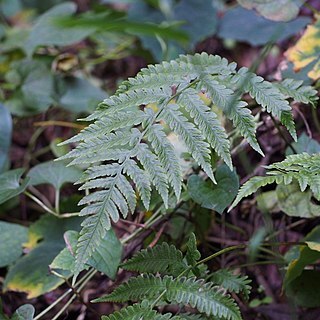Rhizome creeping, branched, up to 120 mm long, up to 5 mm in diam., with fronds up to 15 mm apart, scales castaneous to ferruginous, lanceolate to narrowly ovate, up to 5 x 1 mm. Fronds erect to arching, up to 450 mm long, up to 6 per plant. Stipe atrocastaneous, firm, shallowly sulcate adaxially, up to 300 mm long, up to 2.2 mm in diam., with scales and hairs; scales similar to those on rhizome; hairs acicular or cylindrical, up to 0.8 mm long. Lamina 1-pinnate-pinnatifid, ovate, up to 310 x 280 mm. Rachis sulcate adaxially, densely set with scales and hairs similar to those on stipe. Pinnae firmly herbaceous, pinnatifid, basally more widely spaced, basal pinnae not reduced, narrowly lanceolate to oblong-acuminate, up to 168 x 40 mm, basal pinna pair often basiscopically developed. Pinnules oblong-cuneate to oblong-obtuse, up to 31 x 10 mm, crenulate, adaxially regularly set with pluricellular acicular hairs along and between veins, abaxially moderately set with acicular hairs along veins; venation evident, pinnately branched, free. Sori linear, up to 3 mm long, often back-to-back, usually on acroscopic vein branches. Indusium stramineous, linear, up to 3 x 0.3 mm, fimbriate, often with acicular and cylindrical hairs terminating in an enlarged gland-like cell occurring on the surface.
Plants summer-green. Rhizome slender, creeping, apex with yellow-brown, broadly lanceolate or lanceolate scales; fronds distant to approximate. Fertile frond up to 1 m; stipe scaly and hairy; lamina bipinnatilobate, oblong or broadly oblong-lanceolate, sometimes triangular, base slightly or not reduced, apex long acuminate or abruptly narrowed, acuminate; pinnae 4-8 pairs, oblique or occasionally spreading, straight or subfalcate, oblong-lanceolate or lanceolate, base subtruncate, apex long acuminate or caudate; pinna lobes 5-18 pairs, oblique at angles of 40°-45°, rectangular or oblong, or falcate-lanceolate, margin sparsely dentate or repand, rarely shallowly lobed, apex subtruncate or rounded to acute; veins pinnate with less than 8 pairs of veinlets, oblique, forked or simple, often not prominently adaxially, slightly visible abaxially. Lamina herbaceous, rachis with sparse pale brown lanceolate scales and nodose soft hairs, costae and veins with nodose hairs on both sides. Sori shortly linear, straight, mostly single, medial, double on basal acroscopic veinlets; indusia pale brown, membranous, glabrous, margin lacerate, incurved when young. n = 120 (6´).
Rhizome creeping, c. 5 mm in diameter, set with lanceolate, clathrate, brown rhizome-scales. Fronds spaced 5-10 (-20) mm apart, arching, herbaceous, up to c. 0.75 m tall; stipe light brown, becoming dark brown basally, as long as or longer than lamina, set with clathrate brown scales c. 2-5 mm long; lamina ovate-deltate, 2-pinnatifid, basal pinnae not conspicuously reduced and basiscopically developed, set with minute multicellular hairs along veins on both surfaces; pinnae lanceolate, attenuate, deeply pinnatifid into rhombic, somewhat falcate lobes c. 8 x 6 mm, each lobe serrate-dentate laterally, dentate apically; rhachis sulcate, pubescent with minute multicellular hairs and set with scattered scales; costae sulcate, pubescent. Sori borne along veins, some back to back, up to 3.5 mm long and 0.3 mm broad; indusium pale brown, membranous, erose-lacerate.
Rhizome creeping, scaly. Fronds closely or widely spaced. Stipe base swollen or not. Lamina not pentagonal in outline, pinnatifid to 2-pinnatifid, decrescent or not. Sori curved, narrowly oblong, straight or occasionally J-shaped. Indusium lateral.

